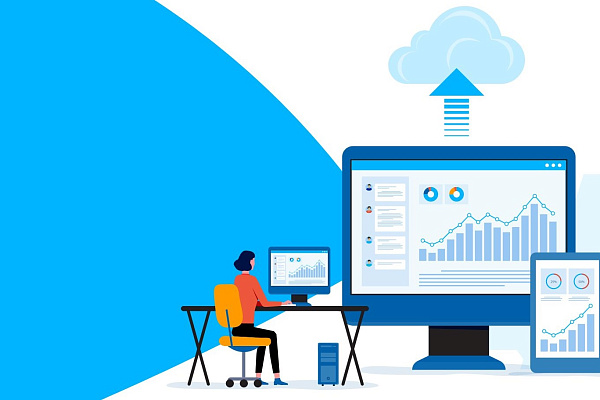Environmentally friendly approach to ICT (information and communication technologies) is a global imperative that must be implemented on a mandatory basis. All companies involved in the ICT area, including providers of cloud services should take this into account in their work and improve their products.
Modern cloud providers have no other choice but to rethink their ways of change and interaction with existing systems and techniques develop new approaches to infrastructure if the ICT will continue to be in the service of the "digital" world community.
These are bold statements, but they are based on studies, proving the harsh realities.
The root of all evil
Global CO2 emissions from all enterprises of the ICT sector employs 2% of the total. It's about 830 metric tons of CO2, which is comparable with the carbon emissions from the aviation industry, which is universally inclined for your "contribution" to the pollution of the environment. According to forecasts, the share of discharge information and communication enterprises will double by 2020, i.e. in just 4 years.
Global consumption of Internet services, which are based on activities of information and communications companies, will grow by 30%-40% annually. If the predictions are true, then for 10 years the volume of Internet traffic will increase 30 times (given the complexity of the formula, within 20 years its volume will increase 1000 times). If nothing is done, it is only for 10 years of enterprise information and communications industry will consume about 60% of global energy resources – an excessive burden for the environment.
When optimizing the energy efficiency of ICT 1,000 times over a 20 year period, no changes in energy consumption and harmful emissions may not occur.
The cloud or the problem?
The cloud has both advantages and disadvantages in enhancing the sustainability of information and communication technologies.
It is known that the cloud can provide a specific resource pool for customers with much less cost than in self-filling infrastructure appliances and software. This means removing the load of computing resources and storage resources information in favor of remote locations such as cloud storage (like DropBox are known to all). These remote data center of today is characterized by high stability and taking into account existing best practices can use renewable energy sources.
Cloud business is good because it reduces energy costs, and large cloud-based providers understand the problems of the development of clouds and the impact of this development on emissions of CO2.
On the other hand, the fact that cloud computing are remote data centers, tends to significantly affect the energy efficiency of the cloud. Affordable cloud computing in terms of speed of deployment and in terms of cost is pushing more organizations to use them, exacerbating environmental problems.
What to do?
There are two ways of interaction of cloud technologies and "green" approach to ICT. First, to ensure that all cloud-based ICT maximally energy efficient, starting from the smallest sensors to entire data centers. The second is to use cloud services and ICT together to create energy efficient technologies, systems and processes to consumer needs and industry verticals.
When using the first method the re-engineering of the entire "backbone" for more efficiency. New paradigms for achieving this goal include software defined networking or network virtualization, which can separate the control plane and the data plane transmission.
"The cloud" in action also requires a cyber-physical solutions. Energy-efficient management of virtual machines (VMS), energy efficient containers as service containers as a service – CaaS), scaling of energy-efficient networks, and even infrastructure management with renewable energy sources – all of which now focused on the cyber sphere and acts for the benefit of her.
Knowledge of the physical world is also crucial. For example, the continuous monitoring of the thermal state of the datacenter and the adoption of heat-sensitive solutions for virtual machines, and CaaS are required. Although the researchers are studying this problem, we need standard protocols and interfaces for sustainable and environmentally secure cloud networking.
 From the point of view of users, the deployment of the "cloud" will improve the environment. For example, people who work on common documents, as a rule, use the exchange of messages and files via e-mail, proudly noting that they did not use paper. A more sustainable cloud approach involves the use of online tools for collaboration instead of local computers, which are known to be excrete up to 40% of the world total of greenhouse gases.
From the point of view of users, the deployment of the "cloud" will improve the environment. For example, people who work on common documents, as a rule, use the exchange of messages and files via e-mail, proudly noting that they did not use paper. A more sustainable cloud approach involves the use of online tools for collaboration instead of local computers, which are known to be excrete up to 40% of the world total of greenhouse gases. This transition is in the competence of providers of SaaS (software as a service), which needs therefore to modify the design via the cloud to encourage more end users to migrate to the cloud. In this case the use of platform as a service (PAAS) "the cloud" remains as though isolated, inhibiting the development of CaaS.
If you choose the second method we can use computing power and large amounts of data available in the cloud to develop the most energy-efficient technologies, systems and processes to protect the environment. An example is the production and diffusion of market models for the energy capacities that have the greatest negative impact on carbon balance in the atmosphere. The intelligent network is a step in this direction, making current practices more efficient and intelligent use of distributed energy resources.
We reviewed the dual needs led to the creation in January 2015 Environmental standard ICT Institute of electrical and electronics engineers (IEEE Green ICT Initiative), whose mission includes a complete rethinking of design, creation and use of ICT. The initiative works with 16 diverse communities IEEE, which covers such topics as cloud computing, Internet of things, big data, smart cities and smart grids, and leading research institutions around the world. To join this initiative.
Multi-faceted world
A new multidisciplinary approach, coordinated by the Environmental forces of the IEEE, needs to create different types of cooperation, like the cooperation of IT specialists with professors of chemistry and biomolecular Sciences.
This example of collaboration has already spawned the creation of recycle-based paper using portable sensors that do not consume energy, but also can track changes in their environment. Interacting on the basis of mobile communication, they can replace the usual environmental sensors are used for cloud computing.
The strategy of the future
Today we are working on energy savings in the data collection process when the use of cloud technologies and in the process of bi-directional communications required in "the cloud". Midterm goals include the search for energy resources for each step in cloud processes. In the longer term it should move in the direction of creation for the "cloud" of devices without batteries and the need to do any food, and possibly redesign the structure of the data center in principle. In some sense, the future of our digital society depends on the effectiveness of all these efforts to achieve the productive work of the cloud and ICT as a whole.




